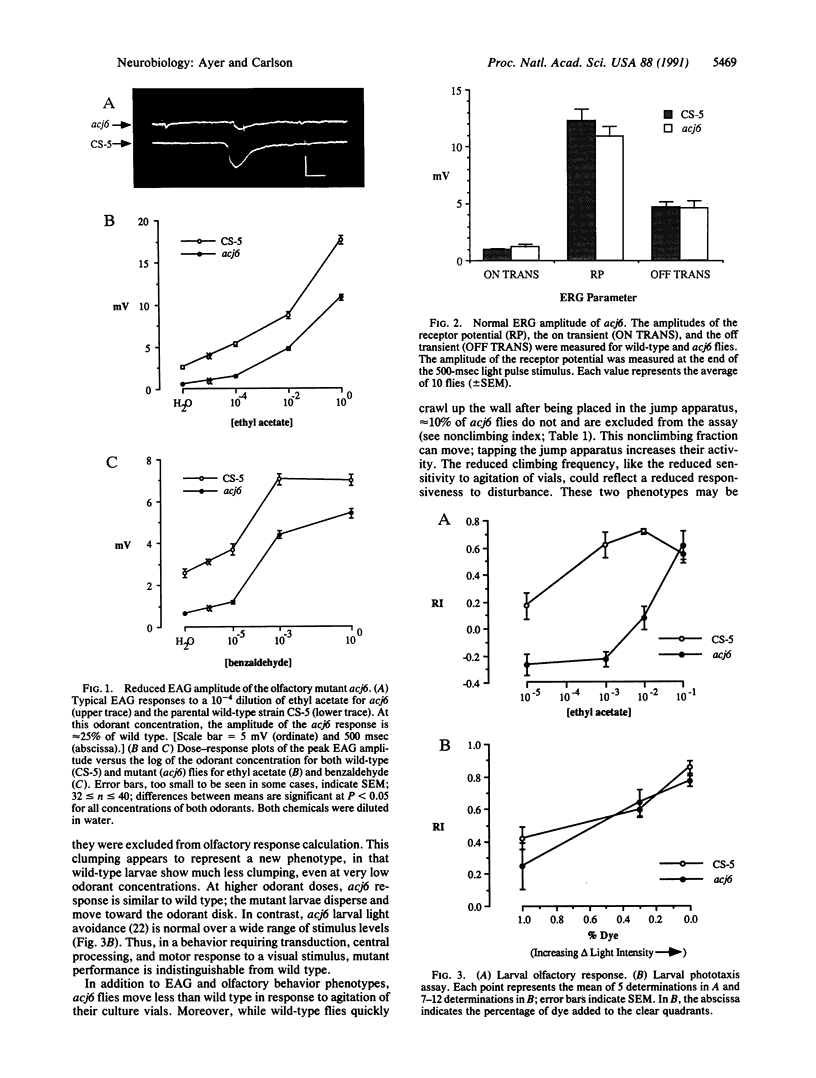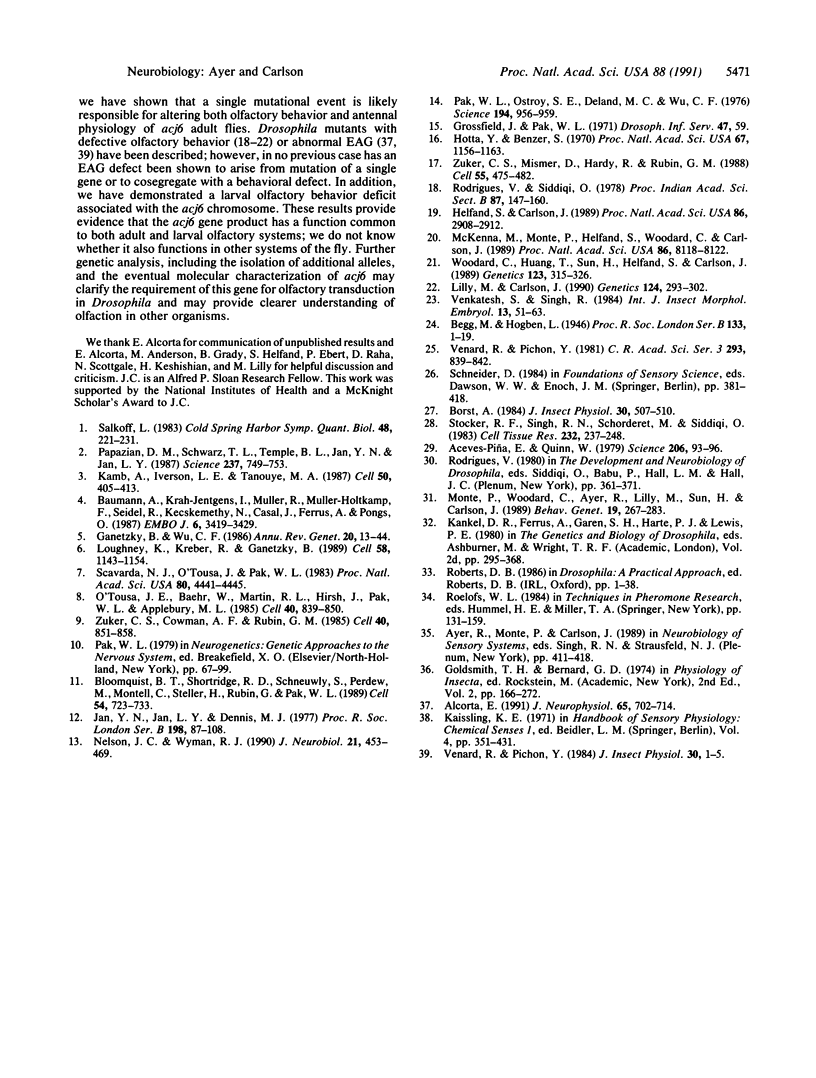Abstract
Mutations affecting olfactory behavior provide material for use in molecular studies of olfaction in Drosophila melanogaster. Using the electroantennogram (EAG), a measure of antennal physiology, we have found an adult antennal defect in the olfactory behavioral mutant abnormal chemosensory jump 6 (acj6). The acj6 EAG defect was mapped to a single locus and the same mutation was found to be responsible for both reduction in EAG amplitude and diminished behavioral response, as if reduced antennal responsiveness to odorant is responsible for abnormal chemosensory behavior in the mutant. acj6 larval olfactory behavior is also abnormal; the mutation seems to alter cellular processes necessary for olfaction at both developmental stages. The acj6 mutation exhibits specificity in that visual system function appears normal in larvae and adults. These experiments provide evidence that the acj6 gene encodes a product required for olfactory signal transduction.
Full text
PDF




Images in this article
Selected References
These references are in PubMed. This may not be the complete list of references from this article.
- Aceves-Piña E. O., Quinn W. G. Learning in normal and mutant Drosophila larvae. Science. 1979 Oct 5;206(4414):93–96. doi: 10.1126/science.206.4414.93. [DOI] [PubMed] [Google Scholar]
- Alcorta E. Characterization of the electroantennogram in Drosophila melanogaster and its use for identifying olfactory capture and transduction mutants. J Neurophysiol. 1991 Mar;65(3):702–714. doi: 10.1152/jn.1991.65.3.702. [DOI] [PubMed] [Google Scholar]
- Baumann A., Krah-Jentgens I., Müller R., Müller-Holtkamp F., Seidel R., Kecskemethy N., Casal J., Ferrus A., Pongs O. Molecular organization of the maternal effect region of the Shaker complex of Drosophila: characterization of an I(A) channel transcript with homology to vertebrate Na channel. EMBO J. 1987 Nov;6(11):3419–3429. doi: 10.1002/j.1460-2075.1987.tb02665.x. [DOI] [PMC free article] [PubMed] [Google Scholar]
- Bloomquist B. T., Shortridge R. D., Schneuwly S., Perdew M., Montell C., Steller H., Rubin G., Pak W. L. Isolation of a putative phospholipase C gene of Drosophila, norpA, and its role in phototransduction. Cell. 1988 Aug 26;54(5):723–733. doi: 10.1016/s0092-8674(88)80017-5. [DOI] [PubMed] [Google Scholar]
- Ganetzky B., Wu C. F. Neurogenetics of membrane excitability in Drosophila. Annu Rev Genet. 1986;20:13–44. doi: 10.1146/annurev.ge.20.120186.000305. [DOI] [PubMed] [Google Scholar]
- Helfand S. L., Carlson J. R. Isolation and characterization of an olfactory mutant in Drosophila with a chemically specific defect. Proc Natl Acad Sci U S A. 1989 Apr;86(8):2908–2912. doi: 10.1073/pnas.86.8.2908. [DOI] [PMC free article] [PubMed] [Google Scholar]
- Hotta Y., Benzer S. Genetic dissection of the Drosophila nervous system by means of mosaics. Proc Natl Acad Sci U S A. 1970 Nov;67(3):1156–1163. doi: 10.1073/pnas.67.3.1156. [DOI] [PMC free article] [PubMed] [Google Scholar]
- Jan Y. N., Jan L. Y., Dennis M. J. Two mutations of synaptic transmission in Drosophila. Proc R Soc Lond B Biol Sci. 1977 Jul 28;198(1130):87–108. doi: 10.1098/rspb.1977.0087. [DOI] [PubMed] [Google Scholar]
- Kamb A., Iverson L. E., Tanouye M. A. Molecular characterization of Shaker, a Drosophila gene that encodes a potassium channel. Cell. 1987 Jul 31;50(3):405–413. doi: 10.1016/0092-8674(87)90494-6. [DOI] [PubMed] [Google Scholar]
- Lilly M., Carlson J. smellblind: a gene required for Drosophila olfaction. Genetics. 1990 Feb;124(2):293–302. doi: 10.1093/genetics/124.2.293. [DOI] [PMC free article] [PubMed] [Google Scholar]
- Loughney K., Kreber R., Ganetzky B. Molecular analysis of the para locus, a sodium channel gene in Drosophila. Cell. 1989 Sep 22;58(6):1143–1154. doi: 10.1016/0092-8674(89)90512-6. [DOI] [PubMed] [Google Scholar]
- McKenna M., Monte P., Helfand S. L., Woodard C., Carlson J. A simple chemosensory response in Drosophila and the isolation of acj mutants in which it is affected. Proc Natl Acad Sci U S A. 1989 Oct;86(20):8118–8122. doi: 10.1073/pnas.86.20.8118. [DOI] [PMC free article] [PubMed] [Google Scholar]
- Monte P., Woodard C., Ayer R., Lilly M., Sun H., Carlson J. Characterization of the larval olfactory response in Drosophila and its genetic basis. Behav Genet. 1989 Mar;19(2):267–283. doi: 10.1007/BF01065910. [DOI] [PubMed] [Google Scholar]
- Nelson J. C., Wyman R. J. Examination of paralysis in Drosophila temperature-sensitive paralytic mutations affecting sodium channels; a proposed mechanism of paralysis. J Neurobiol. 1990 Apr;21(3):453–469. doi: 10.1002/neu.480210307. [DOI] [PubMed] [Google Scholar]
- O'Tousa J. E., Baehr W., Martin R. L., Hirsh J., Pak W. L., Applebury M. L. The Drosophila ninaE gene encodes an opsin. Cell. 1985 Apr;40(4):839–850. doi: 10.1016/0092-8674(85)90343-5. [DOI] [PubMed] [Google Scholar]
- Paj W. K., Istrit S. E., Deland M. C., Wu C. F. Photoreceptor mutant of Drosophia: is protein involved in intermediate steps of phototransduction? Science. 1976 Nov 26;194(4268):956–959. doi: 10.1126/science.824732. [DOI] [PubMed] [Google Scholar]
- Papazian D. M., Schwarz T. L., Tempel B. L., Jan Y. N., Jan L. Y. Cloning of genomic and complementary DNA from Shaker, a putative potassium channel gene from Drosophila. Science. 1987 Aug 14;237(4816):749–753. doi: 10.1126/science.2441470. [DOI] [PubMed] [Google Scholar]
- Salkoff L. Genetic and voltage-clamp analysis of a Drosophila potassium channel. Cold Spring Harb Symp Quant Biol. 1983;48(Pt 1):221–231. doi: 10.1101/sqb.1983.048.01.025. [DOI] [PubMed] [Google Scholar]
- Scavarda N. J., O'tousa J., Pak W. L. Drosophila locus with gene-dosage effects on rhodopsin. Proc Natl Acad Sci U S A. 1983 Jul;80(14):4441–4445. doi: 10.1073/pnas.80.14.4441. [DOI] [PMC free article] [PubMed] [Google Scholar]
- Stocker R. F., Singh R. N., Schorderet M., Siddiqi O. Projection patterns of different types of antennal sensilla in the antennal glomeruli of Drosophila melanogaster. Cell Tissue Res. 1983;232(2):237–248. doi: 10.1007/BF00213783. [DOI] [PubMed] [Google Scholar]
- Woodard C., Huang T., Sun H., Helfand S. L., Carlson J. Genetic analysis of olfactory behavior in Drosophila: a new screen yields the ota mutants. Genetics. 1989 Oct;123(2):315–326. doi: 10.1093/genetics/123.2.315. [DOI] [PMC free article] [PubMed] [Google Scholar]
- Zuker C. S., Cowman A. F., Rubin G. M. Isolation and structure of a rhodopsin gene from D. melanogaster. Cell. 1985 Apr;40(4):851–858. doi: 10.1016/0092-8674(85)90344-7. [DOI] [PubMed] [Google Scholar]
- Zuker C. S., Mismer D., Hardy R., Rubin G. M. Ectopic expression of a minor Drosophila opsin in the major photoreceptor cell class: distinguishing the role of primary receptor and cellular context. Cell. 1988 May 6;53(3):475–482. doi: 10.1016/0092-8674(88)90167-5. [DOI] [PubMed] [Google Scholar]





